| In This Issue: Headquarters Training Supports EM Field Sites 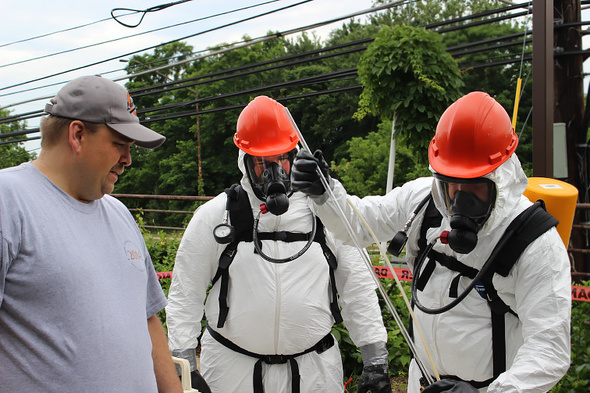 Trainer Randall Rickman, left to right, observes Larry Berg from EM's Safety, Security and Quality Programs office and Tony Pierpoint from DOE's Office of Independent Enterprise Assessments practice chemical sampling during Hazardous Waste Operations and Emergency Response initial training in Germantown, Md. GERMANTOWN, Md. – EM's Office of Safety, Security and Quality Programs sponsored training for headquarters staff for nine days this month to help them better support the Cold War program's cleanup sites around the complex. Held in Germantown, Md., these Radiological Worker II and Hazardous Waste Operations and Emergency Response (HAZWOPER) training courses are required for individuals to enter radiological and hazardous waste areas at EM sites. Thirty-five participants signed up for the training in Germantown. "In the past, we've primarily offered refresher training," said Todd Lapointe, director of EM's Office of Safety Management. "This year, we wanted to give full courses so that new headquarters employees and mission personnel who make frequent site visits could hit the ground running when they travel." The courses in Germantown were taught by trainers from the Laborers' International Union of North America, and courses elsewhere across the DOE complex are taught by other unions at DOE sites. The trainers work on site and have hands-on experience in hazardous waste generation, removal, containment, transportation, or emergency response. The training is the same given to crane operators, carpenters, welders, construction workers, and others through the National Institute of Environmental Health Sciences Worker Education and Training Program, which has had an interagency agreement with DOE over the past 14 years. More than 10,000 DOE federal and contractor workers are trained annually at more than 30 sites, including Hanford, Oak Ridge, Savannah River, and Paducah. "The ability to take this course locally is a great convenience," said Jim Shuler from EM's Office of Packaging and Transportation. "It's been a long time since I've had a similar course, and things have changed, so taking this course will be beneficial to my work." The four courses include: - HAZWOPER initial training, a 40-hour course designed for workers involved in hazardous waste cleanup operations, emergency response operations, and storage, disposal, or treatment of hazardous substances. It covers hazard recognition, physical and chemical properties of hazardous materials, safety basic toxicology, decontamination procedures and practices, sampling, monitoring, material handling, introduction to chemical protective clothing, respiratory protection, site safety plans, and rights and responsibilities under the law. The instruction involves hands-on sessions and simulations of field operations.
- HAZWOPER refresher training, a one-day course that reviews elements of the initial 40-hour training, lessons learned in worker health and safety in hazardous waste operations, and recent changes in regulatory requirements. It reviews information provided in a worker's initial course as well as new technologies, regulatory updates, and recent advancements.
- Radiological Worker II training, a three-day course designed for personnel entering radiological areas and working with radioactive materials. The course covers radiation and its properties, sources of radiation exposure, health effects, radiological posting, personal protective equipment, radiation detection instruments, and personal dosimetry.
- Radiological Worker II Challenge Exam, a one-day course for workers who have previously completed Radiological Worker II training to extend their certification by taking and passing the Radiological Worker II class exam and successfully demonstrating a protective clothing dress-out exercise.
Employees from DOE's Office of Environment, Health, Safety and Security and Independent Enterprise Assessments also joined the four courses. Workers Successfully Excavate Mother Lode of Chromium Contamination at Hanford Site  A hole near Hanford's D Reactor now 85 feet deep is shown when it was about 70 feet deep. RICHLAND, Wash. – EM's Richland Operations Office (RL) and contractor Washington Closure Hanford (WCH) have removed what is believed to be the primary source of chromium contamination to the Columbia River near Hanford's D Reactor after workers excavated 2.2 million tons of material from waste sites. Two waste sites near D and DR Reactors, 100-D-104 and 100-D-30, were merged together, equaling a little more than seven football fields in area at the excavation surface and a single football field in size at the bottom. The excavation at these two sites was close to 880,000 tons. About 1.32 million tons also were excavated from a third waste site, 100-D-100. Together, remediation of all the 100-D waste sites has removed 2.2 million tons of material, of which 760,000 tons of contaminated soils were disposed of in Hanford's onsite disposal facility, the Environmental Restoration Disposal Facility (ERDF). Nearly 60,000-tons of this contaminated material required treatment to meet regulatory requirements prior to disposal. "The completion of these large waste sites removes the mother lode of chromium contamination in the reactor area," said RL Federal Project Director Mark French.  An aerial view of D and DR Reactor sites with the Columbia River. The contamination is the result of sodium dichromate leaks or spills during reactor operations from the 1940s to 1960s. Sodium dichromate was added to the cooling water of eight of Hanford's nine reactors to prevent corrosion of the piping system. Large quantities of the chemical were transported to the reactor areas by rail cars or truck tank cars and distributed by underground piping. The excavations reached groundwater at 85 feet deep. The heavily chrome contaminated soil was treated by mixing it with a chemical reagent and cement and disposing it in the landfill. There are a few cleanup activities remaining in the 100-D Reactor Area such as the completion of the stockpiled soil removal campaign in July 2014; the backfill campaign to start in October 2014; and the revegetation in 2016. "Not only is our team removing and cleaning up chromium contaminated soil, but we are also protecting the Columbia River while working safely," said WCH Closure Operations Director Rob Cantwell. Employee-Driven Initiative Increases Treatment Capacity, Reduces Clean Water Demands 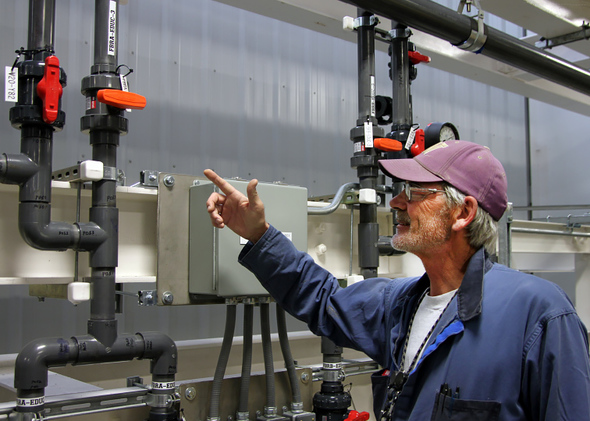 Soil and Groundwater Remediation Project Pipefitter John Reynolds explains some of the modifications he helped make at the 200 West Pump and Treat System that increased its water treatment capability. RICHLAND, Wash. – Workers with CH2M HILL Plateau Remediation Company (CH2M HILL), a cleanup contractor supporting EM's Richland Operations Office (RL), continue to enhance and expand capabilities of a facility that treats legacy contamination at the Hanford site. From its first day of operations in 2012, Hanford's 200 West Pump and Treat System has been a model for efficiency and sustainability, earning Gold Certification by Leadership for Energy and Environmental Design for energy savings, water efficiency, emissions reduction, and indoor air quality. "The contractor and its employees continue to find ways to enhance the efficiency and sustainability of groundwater treatment systems on the Hanford Site," said RL's Hanford Groundwater Remediation Senior Technical Advisor John Morse. "These improvements make us better stewards of our resources as we do this important work to clean up our groundwater and protect the Columbia River, which flows through the Hanford Site." CH2M HILL Soil & Groundwater Remediation Vice President Mark Cherry said the 200 West facility has been an enormous success, treating more than 65 million gallons of contaminated groundwater per month. "But our workforce saw an opportunity to raise the bar even higher, saving valuable natural resources while increasing treatment capacity," he said. Until recently, the groundwater treatment facility near the center of the site used site service water, or treated water, in part of its process to treat contaminated water pumped from the ground. In March 2014, workers implemented design changes to allow the plant to use its own treated groundwater instead of site service water. The modification reduces the amount of water injected into the ground, allowing 42 million more gallons of groundwater to be extracted for treatment each year. The 200 West system is one of the largest plants in the DOE complex that treats radiologically contaminated groundwater. The system combines several technologies to address multiple contaminants in 5 square miles of groundwater beneath Hanford's Central Plateau. It's capable of removing more types of radioactive and chemical contaminants than any other system of its kind in the DOE complex. Back To Top Hanford Site Small Businesses Secure $8.9 Billion in Subcontracts  Washington Closure Hanford, the contractor managing the River Corridor Closure Project for the Richland Operations Office, leveraged subcontractor expertise and equipment to remove a 1,082-ton nuclear test reactor and dispose of it in an approved landfill. The reactor was the largest of Hanford's experimental reactors used for developing and testing alternative fuels for the commercial nuclear power industry in the 1960s. Approximately 50% of subcontracts go to local small businesses RICHLAND, Wash. – Contractors continue to exceed their small business goals by hiring subcontractors at the Hanford site. Working under the purview of EM's Richland Operations Office (RL) and Office of River Protection (ORP), Hanford contractors work diligently to support small business and strengthen small business partnerships. "Our contractors routinely demonstrate their commitment to our community's small businesses while meeting the significant challenges of cleaning up and maintaining the Hanford site," said RL Procurement Division Director Andy Wirkkala. From the beginning of each contract through the end of April 2014, Hanford contractors collectively have awarded a total of $8.9 billion in subcontracting work to small businesses, with almost 50 percent of that total going to local companies. During fiscal year 2013, Hanford prime contractors awarded $669 million in subcontracting work, with $228 million awarded to local small businesses. When expanded to include all of Washington and Oregon, the total subcontracting work going to small businesses increases to $418 million. Small businesses contribute greatly to the success of cleanup at Hanford and provide services, skills and materials that many Hanford contractors rely on to accomplish unique tasks. Small businesses provide a broad spectrum of talent and expertise that allows EM to do work safely, efficiently, and cost effectively. Hanford contractors working for RL include: - Central Plateau contractor CH2M HILL Plateau Remediation Company, whose contract began in 2008;
- Mission Support contractor Mission Support Alliance, whose contract began in 2009; and
- River Corridor contractor Washington Closure Hanford, whose contract began in 2005.
Hanford contractors under the purview of the ORP are: - Waste Treatment and Immobilization Plant contractor Bechtel National, Inc., whose contract began in 2000; and
- Tank Operations contractor Washington River Protection Solutions, whose contract began in 2008.
"Small businesses play a key role in Hanford's cleanup mission," said ORP Contracts and Property Management Division Director Marc McCusker. "Small businesses work in partnership with our Hanford prime contractors on a variety of projects to accomplish the work in a safe and cost-efficient way." EM and Hanford contractors remain committed to helping small businesses grow and positioning them for future success. WIPP Takes Second in Mine Rescue Competition  WIPP Mine Rescue Red Team members' actions are evaluated during a simulated mine rescue disaster. CARLSBAD, N.M. – EM's Waste Isolation Pilot Plant (WIPP) mine rescue team placed second in the Southwestern Regional Mine Rescue Competition this past spring in Carlsbad, and it took home more than a trophy. These teams are a source of great satisfaction for the Carlsbad Field Office (CBFO), which has responsibility for WIPP and the National Transuranic (TRU) Program. Competitions like the one this spring sponsored by the U.S. Mine Safety and Health Administration (MSHA), in which seven New Mexico teams participated, enhance skills in emergency response preparedness. "These competitions are a fundamental part of the training for the mine rescue teams," said Carlsbad Field Office Mine Operations Project Manager Don Galbraith. "They are a validation of proven mine rescue team procedures and processes." MSHA emphasizes that the competitions strengthen cooperation between federal and state agencies, mining companies, and equipment manufacturers to enhance mine rescue preparedness. WIPP has two mine rescue teams — red and blue — that regularly compete and show excellence in the demonstration of their knowledge and skills. The Blue Team could not compete this spring as its team members were on standby while recovery team personnel were performing investigative entries into the WIPP underground following the February radiological event. The Red Team took first place in the competition's first aid contest and received second place overall. MSHA evaluates each team's performance through a simulated mine disaster and rescue scenario. The teams are also evaluated on other skills including gas testing and maintaining a complex self-contained breathing apparatus, and in the technician team and team trainer categories. Through the years, the WIPP teams have earned recognition for their skills. Three members have been inducted into the National Mine Rescue Hall of Fame. "Our mine rescue teams are tops," said CBFO Manager Joe Franco. "Their accomplishments are commendable. Mine safety is essential to our mission. As the manager for the WIPP mine rescue teams from 1997 through 1999, I especially appreciate the teams' skill and dedication to providing extremely well-trained emergency response for our workers, facility, community, and the entire industry." 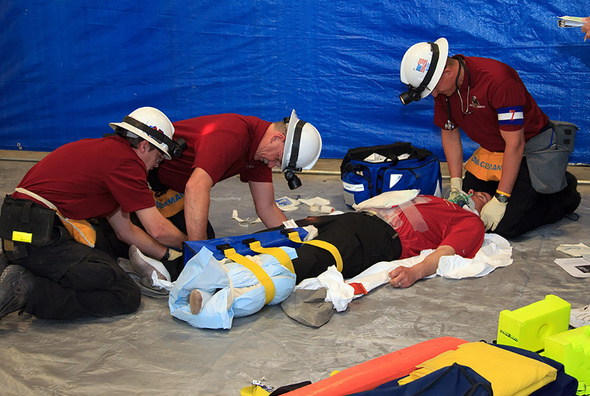 WIPP mine rescue team members simulate the proper first aid response to stabilize injuries. The team members — highly trained professionals integral to the WIPP mission — are employees of Nuclear Waste Partnership (NWP), WIPP's management and operating contractor. "We are incredibly pleased to have such high-caliber employees who stand ready to provide emergency response in the event of a mine disaster," NWP President and Project Manager Bob McQuinn. WIPP, the nation's only deep geologic repository for the disposal of TRU waste, is unique as both a nuclear and mining operation. Given this dual nature, WIPP trains employees to meet federal requirements for both mine and nuclear operations. The state, regional and national mine rescue competitions provide venues for teams to test their skills and increase their capabilities. In addition to providing emergency mine rescue at WIPP, CBFO maintains mine rescue assistance agreements to provide emergency response with two local potash mines in New Mexico and a marble mine near Van Horn, Texas. Experience and practice have proven beneficial to the WIPP mine rescue teams. In February, members were called to enter the WIPP underground to ensure the salt truck fire was completely extinguished and to test for underground air quality. Several years ago, WIPP's teams assisted in the recovery of a man who had fallen into an abandoned mine shaft in central New Mexico. Regardless of the location, WIPP mine rescue teams are at the ready to assist should the need arise. New Savannah River Site Deputy Manager Named AIKEN, S.C. – DOE's Savannah River Operations Office selected Terrel "Terry" J. Spears as the deputy manager of the Savannah River Site (SRS) this month. "We are pleased to have Terry as our deputy manager," Savannah River Operations Office Manager David Moody said. "He has been our acting deputy for about six months now and I am highly confident in his ability to continue steering SRS in the right direction." Reporting to the site manager, Spears has responsibility for approximately $1 billion in annual operating and construction activities. He is a career member of the Senior Executive Service with more than 35 years of federal service in DOE and the Department of Defense. 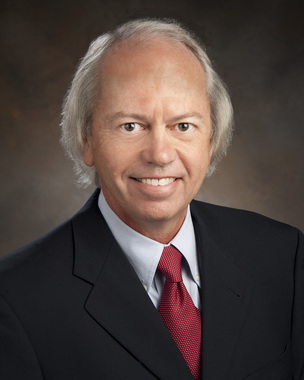 | |
DOE named Terrel "Terry" J. Spears the new deputy manager of the Savannah River Site. | Spears has served as assistant manager for the site's Waste Disposition Project, director of the Salt Waste Processing Division, federal project director for the Salt Waste Processing Facility, director of the Site Integration and Planning Division, and deputy assistant manager for Science, Technology and Business Development. Spears has had a distinguished military career, including active and reserve duty in the Army and Navy. He is retired from the Navy Reserve with the rank of captain. He holds a bachelor's degree in civil engineering from the University of Florida and master's degree in engineering from the University of South Carolina. Savannah River Remediation, College Create Job Opportunities for Graduates AIKEN, S.C. – Savannah River Remediation (SRR), the liquid waste contractor for the EM program at the Savannah River Site (SRS), requires workers with unique skills to protect employees from radiation as the company works safely toward completing its mission. SRR has nine new employees with those skills, and they are helping treat and disposition radioactive waste and close waste tanks. They are all graduates of Aiken Technical College (ATC), a public, two-year institution. Workers in SRR's Radiological Protection Program ensure adherence to regulatory requirements and provide radiological support to the workforce. They are trained and qualified to use specialized survey instruments that monitor radiation and contamination. Radiological protection inspectors and their supervisors guide workers in the radiological aspects of the job to minimize worker exposure to radiation and to prevent the spread of contamination. SRR wants skilled workers who can quickly transition from the classroom to the field. "The ATC students we have employed are doing a good job in a needed field," SRR President and Project Manager Ken Rueter said. "They have learned how to safely operate and perform within our mission, and it's a testament to the quality of their training and their passion to do outstanding work." 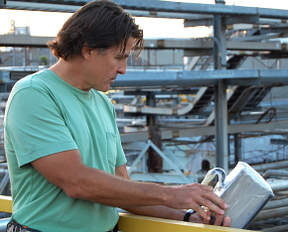 | |
SRR Radiological Protection Inspector Tony Spence, who graduated from ATC, performs radiation monitoring duties. | ATC President Dr. Susan Winsor said the college's relationship with SRR and other nuclear-related companies allows students to obtain real world experience, making them better trained and more employable. "With ongoing missions at the Savannah River Site and construction at Plant Vogtle and V.C. Summer Nuclear Power Station, the nuclear industry in our region is poised for tremendous growth," Winsor said. "By working closely with our nuclear industry partners like SRR, we are able to ensure that the industry's workforce needs are met and our citizens have the high-quality training needed to secure careers in this high demand industry." SRR Senior Radiological Protection Inspector Seth DuVall said ATC prepared him well for the work he does. "My profession – what I do at SRR – is exactly what I was trained for at Aiken Technical College," he said. Tony Spence is an SRR radiological protection inspector who graduated from ATC. He is a non-traditional student who wanted a new career direction. "I decided to re-tool myself when, after working in manufacturing for 26 years, I knew I wanted a different job," said Spence. "I made a list of what types of jobs I wanted, and radiological control could not have fit any better. I thoroughly enjoy my job." DOE Signs Notice to Prepare Environmental Assessment on Proposed Project with Germany  EM Acting Assistant Secretary David Huizenga signs the notice of intent in late May. WASHINGTON, D.C. – The Energy Department recently signed a notice of intent to prepare an environmental assessment to analyze the potential environmental impacts from a proposed project to accept used nuclear fuel from the Federal Republic of Germany at DOE's Savannah River Site (SRS) for processing and disposition. A public meeting on the proposed project was held near SRS on June 24. DOE proposes to accept, process, and disposition used nuclear fuel from Germany containing approximately 900 kilograms of highly-enriched uranium (HEU) from the U.S. The used nuclear fuel is composed of kernels containing thorium and U.S.-origin HEU embedded in thousands of small graphite spheres. The fuel was used in pebble bed research reactors. The Department would install a capability in H-Canyon at SRS to chemically remove graphite from the fuel kernels via a molten salt technique being developed by EM's Savannah River National Laboratory, which is part of the DOE's network of national laboratories. The assessment will analyze potential environmental impacts of transporting the fuel to SRS, storage and processing at SRS, and alternatives for disposition of the HEU that would be separated from the fuel kernels. While no decision has been made to accept this fuel, the planned cooperation would support efforts by the U.S. to reduce and eventually eliminate HEU from civil commerce. By removing U.S.-origin HEU from Germany and returning it to the U.S. for safe disposition, DOE could render it unusable in a nuclear weapon or an improvised nuclear material dispersal device. All work to support DOE's evaluation will be funded by the German government. EM Laboratory Researcher James Marra Recognized for Leadership AIKEN, S.C. – Dr. James Marra, an investigator with EM's Savannah River National Laboratory (SRNL), was named the 2014 recipient of the D.T. Rankin Award for exemplary service to the Nuclear and Environmental Technology Division of the American Ceramic Society (ACerS). An ACerS member for nearly three decades, Marra joined the society as a student member and served on its board of directors from 2009 to 2012. Marra received the award for his leadership within the division, professionalism, and participation in technical activities and innovation. He will be presented the award at the society's annual meeting in Pittsburgh in October. The late Tom Rankin was an SRNL employee who served as chairman of the ACerS Nuclear and Environmental Technology Division. Rankin worked to expand the division's reach in environmental areas. Much of the division's work involves applying ceramic technologies to waste management and environmental remediation. Marra said the award has great value to him because he was Rankin's coworker and friend.  | |
SRNL Investigator Dr. James Marra | "This is the most meaningful recognition I have ever received in my career. Tom provided me many opportunities and was a trusted advisor and friend along the way. I am very proud and humbled to win this award. Tom hired me at SRNL in 1990 and was my first supervisor," Marra said. Rankin encouraged him to become a member of ACerS. "He was truly a mentor and was the one who got me actively involved in the American Ceramic Society. Although I was a member, I had not participated other than attending conferences. I was working again for Tom when he passed away. Tom was an inspiration and this award means a great deal to me," Marra said. SRNL is a multi-program applied research and development laboratory for DOE. It applies state-of-the-art science and engineering to provide practical, high-value, cost-effective solutions for the nation's environmental cleanup, nuclear security. and clean energy challenges. Dog Earns Retirement with Former Handler AIKEN, S.C. – Dax, a male German shepherd in the Savannah River Site's (SRS) security canine unit, recently earned retirement by joining the family of one of his former trainers. Trained to detect potential explosive threats, Dax served with SRS security contractor WSI-SRS starting in 2007. After being diagnosed with intervertebral disc disease earlier this year, Dax retired from the unit and reunited with the former trainer, Patrick Price. Canine teams form a mutual trust, growing to depend on teammates for support and companionship. Retiring a canine that served SRS is difficult due to the bond with the partner. 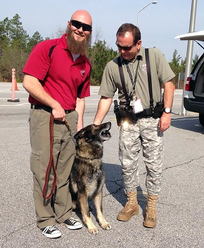 | |
Wade Sumner, Dax's last handler at SRS, says goodbye to Dax as the dog rejoins his former handler, federal Special Agent Patrick Price. | SRS Lt. Paul Gerstenberger contacted Price, a former WSI canine handler who worked with Dax, regarding the dog's retirement. Now a federal agent, Price asked that he care for Dax in retirement. "I'm extremely pleased that Dax has found a home and is now reunited with Patrick," Gerstenberger said. "I'm confident he will receive the care he has earned through his faithful service to our nation." Price found that his bond with Dax remained strong despite the years apart. "Dax was like a member of my family when I had the privilege of being his handler," Price said. "Now that he has retired, it's an honor to have him live out his retirement years as a member of my family again." Project Develops Student-Stakeholders 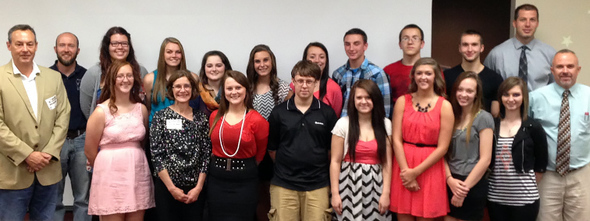 Portsmouth Gaseous Diffusion Plant Site Lead Joel Bradburne, far left, stands with faculty, staff, and students of Eastern High School during an ASER Summary Project recognition ceremony. PIKETON, Ohio ̶ High school students are learning valuable skills while helping EM provide important information to the public about the Portsmouth Gaseous Diffusion Plant. Portsmouth Site Lead Joel Bradburne delivered that message to Eastern High School students during a recent ceremony recognizing their work on the plant's Annual Site Environmental Report (ASER) summary. The ASER report details site environmental conditions and remediation efforts. Administered by the Ohio University Voinovich School of Leadership and Public Affairs through a DOE grant, the project engages high school students in summarizing the technical ASER report into a document intended for a public audience. The final ASER summary will be distributed publicly this fall. "This report not only provides the public with valuable information, but has also led to some of our area's young people becoming very informed stakeholders on the Portsmouth Gaseous Diffusion Plant," Bradburne said. "This effort is part of our educational outreach program that we believe has dramatic impact in our region. The tools they have developed through this program will be beneficial to them as they continue their pursuits." Kaitlyn Thornsberry, a junior at Eastern, said the experience was enjoyable. She found the interactive demonstrations with subject-matter experts valuable. "I thought it would be stressful to do the project and keep up with Mr. (PJ) Fitch's classwork, but it wasn't like that. I found it to be very interesting," she said. "I really liked all the people who came in and provided information and explained how they do things." The project was performed by Fitch's chemistry class, which was divided into five teams to work on the various parts of the ASER. Fitch said it was gratifying to see the growth of his students as the project progressed. "At first, the report was so technical that it was overwhelming to them and to me," Fitch said. "We went from being able to read a sentence or two to me not having to assist them in the end to summarize the project. It was rewarding to see them interact when some of the areas overlapped. There was a lot of cross-group communication that was necessary." Thornsberry said the project piqued her interested in the Piketon plant. "My grandpa used to work there and now I ask him more questions about the site," she said. "I'm more curious now." The student ASER summary and an associated video will be available here when they are finalized. Moab Site is 'Beezy' with a New Kind of Worker  The caped comb shows that the queen bee has laid eggs in the hives. MOAB, Utah – Things are abuzz at EM's Moab Uranium Mill Tailings Remedial Action Project site in Utah. This spring, two Italian honeybee hives were started on the site's northeast portion. Moab Remedial Action Contractor Radiological Control Manager Ron Daily, a hobby beekeeper, noticed a lack of natural pollinators at the Moab site other than wind. He proposed bringing hives to the site to see if the increase in pollination from the bees could enhance revegetation efforts. The Italian bees were chosen because they are less defensive and less prone to disease than their German counterparts, and they are excellent honey producers. Italian bees were brought to the U.S. in 1859 and they quickly became the favorite bee stock in this country. Known for their extended periods of brood rearing, Italian bees can build colony populations in the spring and maintain them the entire summer. The bees are lightly colored, ranging from a light leather hue to an almost lemon yellow, a trait popular with many beekeepers for its aesthetic appeal. Daily, who currently has five hives of his own, became interested in bees because they were dying out and he wanted to help bee colonies live longer. The isolation of the Moab valley limits cross-pollination in bees, which can lead to disease and other problems that shorten their lifecycle. 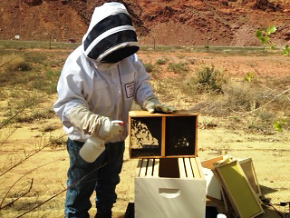 | |
A beekeeper starts a new hive at the Moab site with 3 pounds of bees and a queen. Sugar water is sprayed on the bees before placing them into the hive to keep them calm and prevent them from flying away. | The hives for the Moab site came from central Utah. Each hive comes with 6,000 to 7,000 bees and a queen. After about a year, the bee population will grow to 15,000 to 20,000. The average lifecycle of these bees is 180 days. "They are all about taking care of the hive," says Daily. During their lifetime, bees will progress from caretaking of the hive, to honeycomb making, to flying around pollinating — the last stage before they die. Employees were informed of the plan to bring hives to the site and given opportunity to express concerns but none was voiced. Since their arrival, the bees have been busy settling in, and Daily expects to see an increase in pollination this year. "Honey will not be harvested until next year to let the hives mature," he said. Next year, the bees will produce 30 to 40 pounds of honey. The local bee inspector will also keep an eye on these hives to ensure they remain healthy and disease free. Contributors Tim Boulay, EM headquarters Dean Campbell, Savannah River Site Lana Cox, Savannah River Site Ron Daily, Moab site Rob Davis, Savannah River Site Edgard Espinosa, EM headquarters Rick Greene, Portsmouth site Deanna Hawkins, Hanford site Rochelle Juette, Hanford site Deneen Revel, Portsmouth site Kelly Rhodes, Hanford site Wendee Ryan, Moab site Amy Scales, Savannah River Site David Sheeley, EM headquarters Ryan Williamson, Waste Isolation Pilot Plant | 

















No comments:
Post a Comment